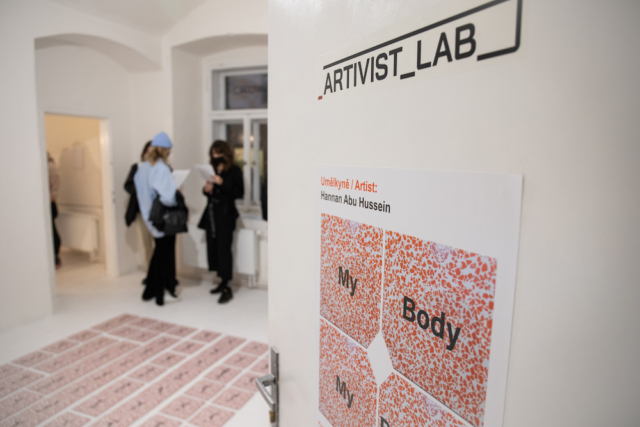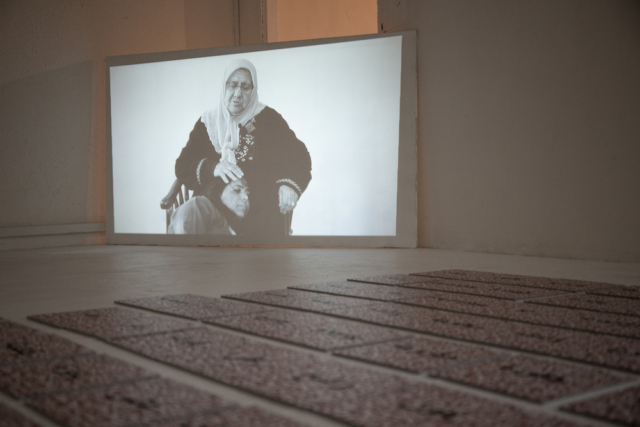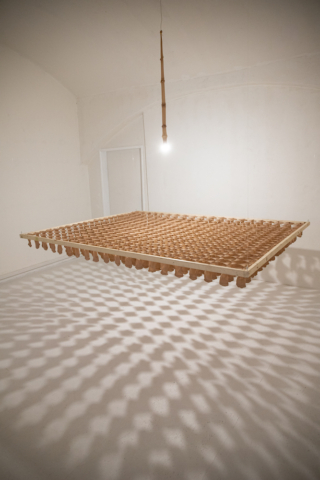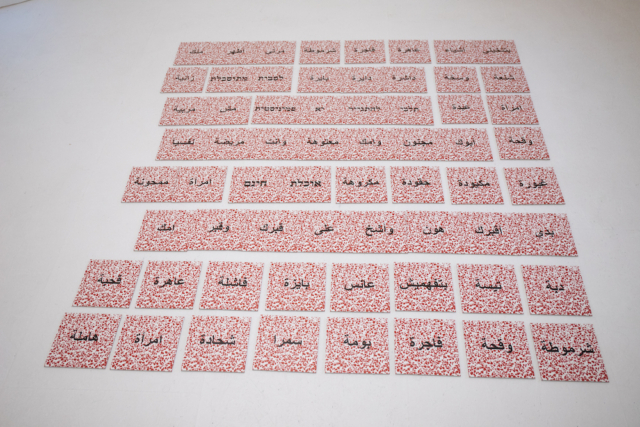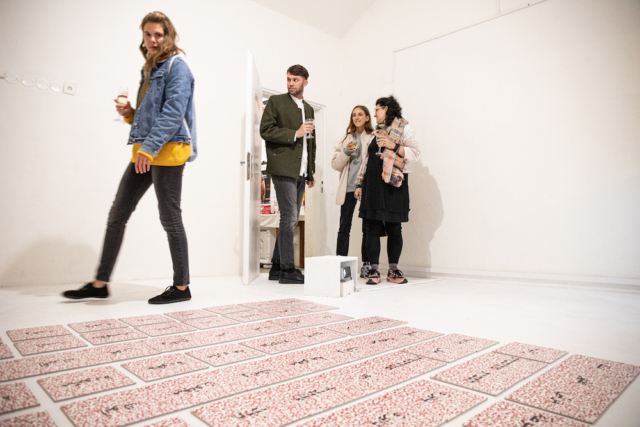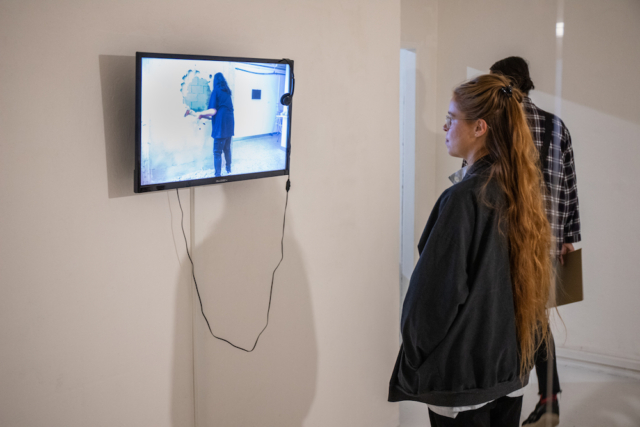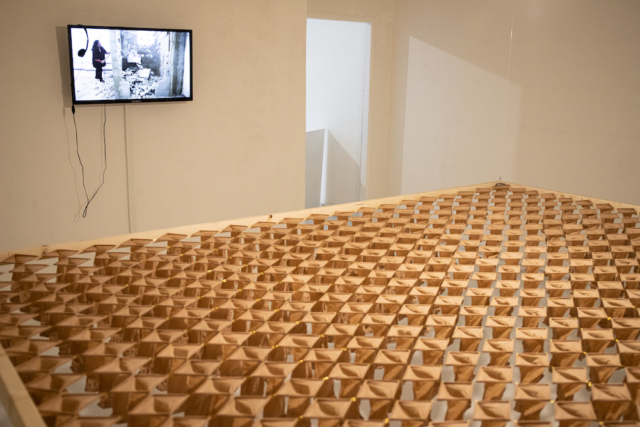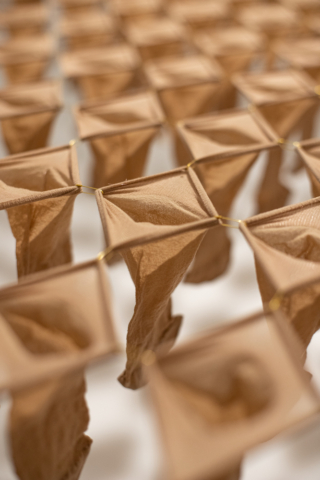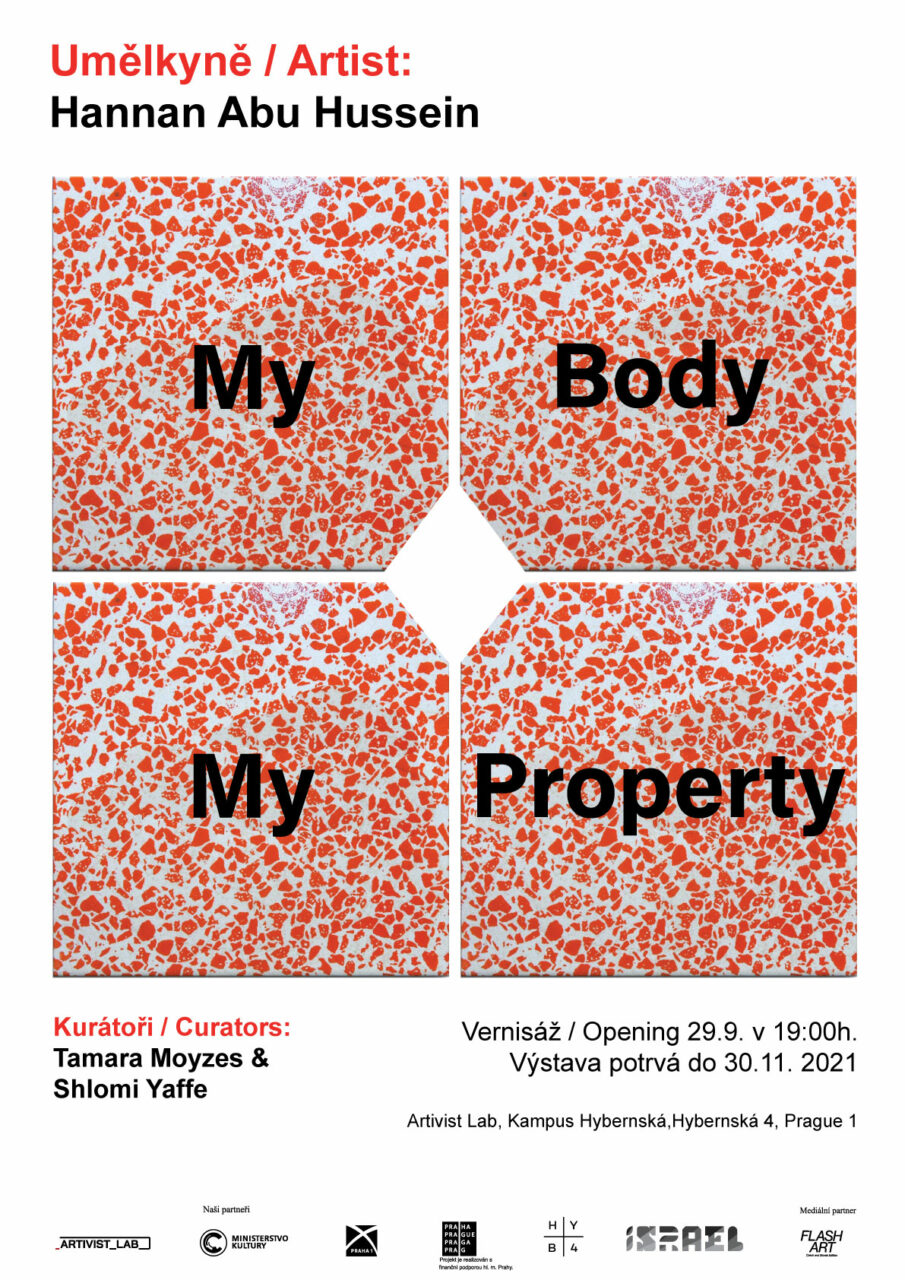for English please scroll down
Moje tělo, můj majetek
Hannan Abu-Hussein je izraelská umělkyně palestinského původu. Ve svých dílech se inspirovala vlastními životními zkušenostmi ženy žijící v arabské segregované společnosti v Izraeli. Pomocí umění zkoumá témata týkající se postavení žen a způsobu jejich fungování v patriarchální společnosti, jako jsou „vyloučení žen“, „násilí“, „čest rodiny“ v arabské společnosti a myšlenkou a funkcí významu “domova”. Ve svých pracích se zabývá otázkami setkání arabské a židovské kultury v izraelské společnosti. Hannan tvrdí, že vizuálně spracováva fakt, že je umělkyně, která má palestinskou a izraelskou identitu. Práce, které vystavuje v galerii Artivist Lab, se zabývají touto smíšenou identitou a současným stavem palestinských žen, kritizující palestinský patriarchát.
Jako žena a arabská umělkyně, která za posledních dvacet pět let veřejně deklarovala svůj feminismus, zažila Hannan nenávistné projevy ve své vlastní rodině. Ve své práci „Dlaždice z červené terakoty“ shromáždila tyto nenávistné projevy v průběhu let, které graficky ztvárnila pomocí černé kaligrafie na červených dlaždicích. Mezi nenávistnými projevy lze číst „Chci tě zde pohřbít a vysrat se na tvůj hrob i na hrob tvojí matky“, „Černoška“, „Lesbička“ nebo „Konvertuj k judaismu, ty feministko“, texty odhalující nepřijetí feminismu v palestinské společnosti.
Ve své instalaci “Je to moje tělo a nikomu nepatří”, která je vytvořena z nylonových punčoch a vytváří vyobrazení vagín ve „formátu mřížky“, která je důležitou součástí avantgardního výtvarného umění v průběhu 20. století, teda její dílo se odvolává na dějiny umění, ve kterých je absence žen, tedy i ženského myšlení. Hannan odpovídá na expropriaci ženského těla palestinským patriarchátem, kde společnost stále ovládá idea ženy jako majetku a žena jako otázka rodinné cti, což vede k domácímu násilí a vraždám ze cti. Ve svém díle subverzivně odmítá mužskou motivaci k nadvládě nad ženami a hovoří o ženě, která si smí dělat, co se jí zlíbí
„Talisman“ je video, které ukazuje, že umělkyně musí být uzdravena a chráněna před jednotlivci, kteří by jí mohli ublížit. Sedí vedle kolen své matky, která jí žehná v arabské mantře. Video je nepřístupné pro ty, kteří nemluví arabsky, což je gesto, které by mohlo komentovat zastíněnou intimitu mezi matkou a dcerou a napětí mezi tradičním islámským rituálem a každodenním životem umělkyně.
Hannanin životopis spolu s jejím videoartem “Sebedemolice”, který komentuje demolici domu ve východním Jeruzalémě, odráží snahu izraelské vlády zastavit jakékoli rozšiřování palestinských vesnic a čtvrtí ve východním Jeruzalémě. Jakýkoli stavební úkon izraelských občanů a obyvatel palestinského původu je izraelským státem kriminalizován, prohlášen za nezákonný, protože nedodržuje územní plán města, a jeho majitelé jsou nuceni jej později zbourat. Hannan ve svém videu podvratně získává roli palestinského muže jako hlavy rodiny, která staví rodinný dům. Protiprávně staví dům s vědomím, že musí být zbourán a odhaluje tak krutost této izraelské politiky. Drží těžké kladivo a bourá zdi, vyčerpává se těžkou prací a zároveň protestuje proti nerovnosti v izraelském státě.
Abú Husajn k tomu poznamenává: “V Jeruzalémě žiji a pracuji již 20 let a denně pozoruji náročnou situaci, v níž se Palestinci nacházejí. Tato pozorování ve mně jako v jakémsi vnějším pozorovateli, a zejména jako feministce a politické aktivistce, která vyzývá ke společným aktivitám Izraelců a Palestinců, vyvolávají palčivé otázky. Dříve jsem věřila, že umění dokáže zmenšit rozdíly mezi různými kulturami. Dvacet let pracuji v Isawiji a Silwánu a každý den vidím z okna ničení domů, které byly postaveny bez povolení. Mnoho obyvatel nedokázalo získat stavební povolení, a tak se uchýlili ke stavbě svých domů bez něj. Bylo jim oznámeno, že buď si dům zbourají sami, nebo jim ho zničí Izraelci a v tom případě také dostanou pokutu 40 000 šekelů. Moje práce je částečnou rekonstrukcí, respektive kopií domu v Isawiji,který jsem si sama postavila a zničila. Zahrnuje skutečné stavební části z domu, který byl v Isawiji zbořen. Samotné budování a následné ničení je obtížné. Slyšela jsem dítě, které, zatímco stálo v troskách jejich domu, říkalo svému otci: “Slíbil jsi, že mi postavíš pokoj, a pak jsi ho zničil”. Co zůstane v paměti tohoto dítěte, jehož byl vysněný pokoj zničen? Co zůstane z jeho vzájemného vztahu s otcem?”
V rámci ocenění pro mladé umělce ji ministerstvo školství státu izrael popsalo jako „vědomou a nekompromisní umělkyni, která používá nabitá obrazná pojmenování, která se dotýkají specifických charakteristik zabývající se postavením žen v arabské kultuře.
Hannan Abu Hussein se narodila v roce 1972 v Umm al-Fahmu, žije a pracuje v Jeruzalémě a je výtvarnou umělkyní, sochařkou, lektorkou a učitelkou. Vystudovala dějiny umění na Hebrejské univerzitě v Jeruzalémě, bakalářský titul z umění a designu a doplňkový program keramického a sklářského designu získala na Akademii Bezalel. Je absolventkou Programu managementu kulturních a uměleckých institucí na univerzitě v Tel Avivu. Je držitelkou Ceny Becky Dekel 2019 za vynikajícího umělce udělované Asociací pro umělecká a genderová studia a Ceny Jerusalem Municipality Leadership 2019 za vynikajícího učitele. Kromě toho získala v roce 2014 cenu ministra kultury a v letech 2011 a 2010 cenu Ministerstva kultury pro umělecké pedagogy. Hanan je první arabskou umělkyní, která v roce 2004 obdržela Cenu Ministerstva školství pro mladé umělce a v letech 1998 a 2002 Cenu Sharettovy nadace. Působí jako profesorka na uměleckých školách Kibbutzim a Shenkar a vyučuje také v Izraelském muzeu a na škole ve východním Jeruzalémě.
Curators: Tamara Moyzes and Shlomi Yaffe
The exhibition is supported by the Israeli embassy in Prague
My Body, My Property
Hannan Abu-Hussein is an Israeli artist of Palestinian descent. In her works, she often deals with questions of identity and locality, gender, segregation, and encounters between the Arab and the Jewish cultures in Israeli society. As an artist who has Palestinian and Israeli identities, Hanan claims to give it a form through visual art. The works she presents in Artivist Lab galley deal with this blended identity and the status quo of the Palestinian females, who are being harmed by the Palestinian patriarchy.
As a female and Arab artist who’s declaring her feminism publicly for the past twenty-five years, Hannan experienced hate speech from her own family. In her work, ‘Red terracotta tile’, she collected these hate speech over the years and designed them in black-colored calligraphy on red spots. Among the hate speech, one can read ‘I want to bury you here and shit on your grave and your mother’s, ‘Black woman’, ‘Lesbian’ or ‘Go get converted to Judaism you Feminist’, unveiling the unacceptance of feminism in the Palestinian society.
In her ‘It’s My Body and Doesn’t Belong to Anyone’, an installation constructed from nylon stockings, and produced imagery of vaginas as an art grid, which could be addressed to the man’s doing in the history of art, Hannan is corresponding to the expropriation of the female body by the Palestinian patriarchy, where society is still dominated by the perception of property and honor, leading to domestic violence and Honor killing. In her work, she subversively rejects the men’s motivation for dominance over women and speaks of a woman who is allowed to do as she pleases.
‘Talisman’ is a video that depicts the artist’s need to be healed and protected from the individuals that might harm her. She is sitting next to her mother’s knees who bless her in Arabic mantra. The video is inaccessible to those who are not speaking the Arabic language, a gesture that might comment on the shielded intimacy between the mother and daughter and on the tension between the traditional Islamic ritual and the artist’s everyday life.
Hannan’s biography along with her work ‘Self demolition’1, a video art commenting on a house demolition in East Jerusalem, correspond to the Israeli government attempt to halt any expansion of Palestinian villages and neighborhoods in East Jerusalem. Any construction act of Israeli citizens and residents of Palestinian descent is being criminalized by the Israeli state, proclaimed to be illegal by not following the city’s master plan, and force to be demolished later by its landowners.
In her video, Hannan subversively obtains the Palestinian men’s role as the head of the family who constructs the house for the family. She is revealing the cruelty of this Israeli policy, by constructing the illegal house with the awareness that it needs to be demolished. She is holding the heavy hammer and knocking down the walls, she’s becoming exhausted from the tough job and transparent the inequality in the Israeli State.
Regarding this work, Abu Hussein remarks: “I have been living and working in Jerusalem for 20 years and observing the difficult situation that the Palestinians are experiencing on a daily basis. These observations have raised harsh questions for me, as a sort of outside observer, and particularly as a feminist and a political activist who calls for joint activities involving Israelis and Palestinians. I used to believe that art could narrow the gaps between different cultures. For 20 years, I’ve been working in Isawiya and Silwan, and every day I see from my window the destruction of houses that were built without a license. Many residents couldn’t obtain a license, and thus resorted to building their homes without one. They were told that they could either destroy their own house, or have it destroyed by the Israelis, in which case they would also receive a 40,000-shekel fine. My work is a partial reconstruction, or duplication, of a house in Isawyia, which I build and destroy myself. It includes actual remnants from a house demolished in Isawyia. The act of building something and then destroying it is difficult. I heard a child saying to his father, while standing on the ruins of their house: ‘You promised to build me a room, and then you destroyed it.’ What will remain in the memory of this child, after the room he dreamt about was destroyed? What will remain of his relationship with his father?”
1. The installation “Build Your Home and Destroy It with Your Own Hands” (2021) was originally commissioned for the exhibition InConcrete Stones at the Art Cube Artists Studios, Jerusalem, curated by Maayan Sheleff.
Hannan Abu Hussein, Born in Umm al-Fahm, 1972, Lives and works in Jerusalem, is a visual artist, sculptor, lecturer, and educator. She is a graduate of the Department of Art History at the Hebrew University of Jerusalem, holds a bachelor’s degree in art, Bezalel Academy of Art and Design and additional program studies in the Department of Ceramic and Glass Design at Bezalel, a graduate of the program for managing cultural and art institutions at Tel Aviv University. In 2019 she won the Becky Dekel Award from the Association for the Study of Art and Gender for Outstanding Artists, and the Jerusalem Municipality Guidance Award for Outstanding Teacher 2019, in addition, she won the Minister of Culture Award for 2014, Teacher Artist Award from the Ministry of Culture 2011and 2010. Hanan is the first Arab artist to win an award from the Ministry of Education for a young artist in 2004, and the Sharett Foundation Award, in 1998 and 2002.
She is a professor at the Kibbutzim and Shenker art colleges, she also teaches at the Israel Museum and the school in East Jerusalem.
Curators: Tamara Moyzes and Shlomi Yaffe
The exhibition is supported by the Israeli embassy in Prague

